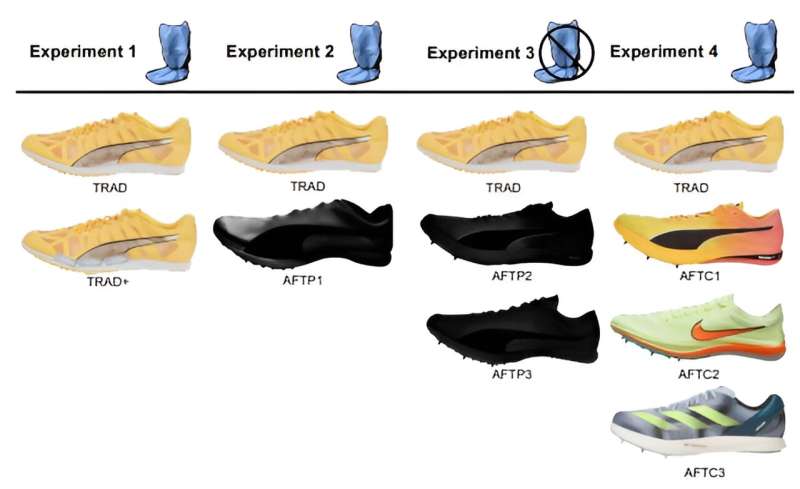This article has been reviewed according to Science X's editorial process and policies. Editors have highlighted the following attributes while ensuring the content's credibility:
fact-checked
preprint
trusted source
proofread
New study shows that 'super spikes' can increase track running speeds by 2%

New research led by the University of Massachusetts Amherst shows that super spikes, scientifically described as advanced footwear technology (AFT) spikes, can give runners about a 2% edge in middle-distance track races, like the 800- and 1,500-meters.
The paper is published on the bioRxiv preprint server.
With the track and field events in the 2024 Paris Olympics starting August 1, the study provides a timely answer to the question of how large the impact of super spikes on running performance is.
"Track athletes started wearing super spikes about five years ago and they are now commonplace in elite track races," says Wouter Hoogkamer, assistant professor of kinesiology at UMass Amherst and senior author of the paper.
"Super spikes have a thicker yet lighter, more resilient and more compliant midsole often combined with a stiff-carbon-fiber plate embedded in the midsole," further explains Montgomery Bertschy, a doctoral student in Hoogkamer's UMass Integrative Locomotive Lab and joint first author of the paper.
"Over the past five years many track records have been broken and that will not be much different during these Olympics," Hoogkamer adds. "Many credit the recent developments in spike technology for this, but scientifically, we don't know that they help. Are athletes running faster because the spikes are faster, or just because they are training better or run on faster tracks?"
To answer this, Hoogkamer brought together an international team of researchers, including Ethan Wilkie, a graduate student at the University of New Brunswick in Canada, and Victor Rodrigo-Carranza, a then-graduate student at the University of Castilla-La Mancha in Spain.
Over a series of experiments, the researchers compared different designs of super spikes with a typical traditional track spike shoe: lightweight in construction with minimal cushioning and no added bending stiffness elements. They found that various designs of super shoes improved running speeds by about 2%, ranging from anywhere from 1.8% to 3.1%.
For the Olympics this begs the question: How much could a 2% speed improvement influence the competition?
"A lot," says Wilkie. "We're showing that shoes matter and particularly that spikes of some brands performed better than others. Historically, we can expect to see differences of less than 0.5% in race time determining who will win the gold, who will get silver, or will not make the podium. Our 2% findings highlight that some of that might be because some people have slightly better shoes than others."
"At the Olympics very few athletes will be running in traditional spikes, but it is important to realize that not all super spikes are equal," Hoogkamer adds.
In the final experiment of the study, the researchers evaluated commercially available shoes. They found that the PUMA evoSPEED LD Nitro Elite+ and Nike ZoomX Dragonfly showed significant improvements in speed of about 2%, but a third model of a different brand showed only 1% improvement and that was statistically not better than the traditional spikes.
As for how super spikes make people faster, the researchers found that the runners took longer steps, rather than faster steps.
"Our results also indicate that over a 1500m race, our participants would take 17 to 21 steps less in super spikes as compared to traditional spikes," says Hoogkamer.
Hoogkamer envisions the innovations that come with this new method.
"Different brands are actually using this protocol now to evaluate their spikes and to find out what's best for a specific distance or for a specific athlete that is either stronger or heavier or faster," he says. "You can go to a specific athlete, have them test spikes with our new protocol and find out: Do you need to wear spike A or B?"
As for what non-Olympians can take away from this study, he says it can help people understand that yes, athletes are training harder, but also that it's about the shoes.
"This study is mainly going help them interpret that what they see at the Olympics or when world records are broken—that part of it is because the shoes are getting better and better, and we have evidence for that."
The forthcoming paper has been accepted for publication in an upcoming issue of the Journal of Sport and Health Science.
More information: Montgomery Bertschy et al, Self-perceived middle-distance race pace is faster in Advanced Footwear Technology spikes, bioRxiv (2024). DOI: 10.1101/2023.10.25.564056
Journal information: bioRxiv
Provided by University of Massachusetts Amherst





















